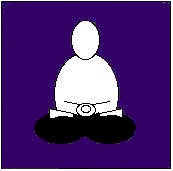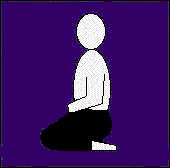|
|
|
Dogen Zenji wrote, "Zazen is the standard or model of true peace and tranquility." Zazen is the very heart of our practice. We always return to sitting. Just sitting. What follows are a few descriptions of zazen postures and basic zazen instruction. It is important to remember that there is absolutely no esoteric significance to the different positions. What is most important in zazen is what you do with your mind, not what you do with your feet or legs. |
|
|
|
Zazen practice and everyday activity are one thing. We call zazen everyday life, and everyday life zazen. But usually we think, "Now zazen is over, and we will go about our everyday activity." But this is not the right understanding. They are the same thing. We have nowhere to escape. So in activity there should be calmness, and in calmness there should be activity...That is why we emphasize everyday life rather than some particular state of mind. |
-Shunryu Suzuki, Zen Mind, Beginner's Mind |
Zazen Postures
|
|
The first and simplest zazen posture is the Burmese position, in which the legs are crossed and both feet rest flat on the floor. The knees should also rest on the floor, though sometimes it takes a bit of exercise to be able to get the legs to drop that far. After awhile the muscles will loosen up and the knees will begin to drop. With the buttocks up on the zafu and your stomach pushing out a little, there will be a slight curve in the lower region of the back. In this position, it takes very little effort to keep the body upright. |
|
The next position is the half lotus.The left foot is placed up onto the right thigh and the right leg is tucked under. This position is slightly asymmetrical and sometimes the upper body needs to compensate in order to keep itself absolutely straight. |
|
|
By far the most stable of all the positions is the full lotus, where each foot is placed up on the opposite thigh. This is perfectly symmetrical and very solid. |
|
Finally, the seiza position. This position is necessary to learn as it also provides the foundation for bowing and prostration. In zazen practice, you can sit seiza kneeling, with the buttocks resting on the upturned feet, forming an anatomical cushion, or you can use a pillow to keep the weight off your ankles. A third way of sitting seiza is to use the seiza bench. It keeps all the weight off your feet and helps to keep your spine straight. |
Simple Zazen Instruction
- Sit on the forward third of your zafu (meditation cushion).
- Arrange your legs as appropriate for your sitting posture- full lotus, half-lotus, Burmese, seiza, or sitting on a chair. Make sure to choose a posture that you can maintain comfortably for the duration of zazen.
- Center your spine by swaying in decreasing arcs.
- Straighten and extend your spine and align your head by "pushing up the ceiling" and then relaxing, originating the thrust at the small of your back. Your belly and hips may both protrude slightly.
- Keep your head centered on your shoulders; it should not tilt forward or backward or lean to either side. Your ears should be parallel with your shoulders, and the tip of your nose should be in alignment with your navel. Tuck in your chin slightly.
- Keep your eyes unfocused and directed toward the floor about 3 to 4 feet ahead of you. They should be neither fully opened or fully closed. Try to "look through the floor," this will minimize blinking.
- Your mouth should be closed, with your lips touching and your teeth together. Place the tip of your tongue against the roof of your mouth, just behind the front teeth, and swallow any saliva. This will evacuate any air and create a slight vacuum, thereby inhibiting salivation.
- Place hands in the "zazen mudra": with hands together, palms up, left on top of right, place the blades of the hands against your lower belly. Allow your thumbs to touch together to form an oval.
- Breathe in slowly through your nose, allowing your lungs to fill with air. Slowly exhale, counting to 10, until all air has been released from your lungs. Try to continue this throughout the zazen period, but do not force your breathing, allow it to be natural and flowing.
- Arrange you body appropriately before beginning zazen.
- Try to keep as still as possible.
|
|
Email Us! nobody@the-i.net
Copyright © 2000 Mindful
Life Sangha
MLS is a
not-for-profit organization. Funds are gathered on a donation basis
only.





